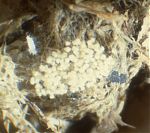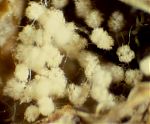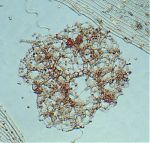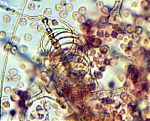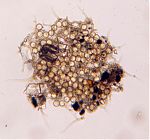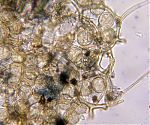Reticulocephalis
RETICULOCEPHALIS Benny, R.K. Benjamin & P.M. Kirk, 1992 (Mycologia 84:633), 2 spp. (Benny et al., 1992—monograph and key to species).
Sporulating heads more or less globose, sessile; fertile hyphae coenocytic initially, septate when mature, composed of coiled hyphae that bifurcate, one branch becoming a sterile spine, some of which adhere to one another at the apex, and the other continuing to grow; at each branching point, except the last 1 or 2, two stalks are produced each bearing a globose fertile vesicle covered with spores. Merosporangia globose to obovoid, unispored, smooth-walled, pedicellate. Zygospores unknown. Possibly a haustorial parasite.
Type species: R. gyrosus
Species of Reticulocephalis:
R. clathroides (Bayliss Elliott) Benny, R.K. Benjamin & P.M. Kirk, 1992 (Mycologia 84:638) (Benny et al., 1992).
≡ Sigmoideomyces clathroides Bayliss Elliott, 1913 (Trans. Brit. Mycol. Soc. 4:123) (Bayliss Elliott, 1913).
R. gyrosus Benny, R.K. Benjamin & P.M. Kirk, 1992 (Mycologia 84:635) (Benny et al., 1992).
The cardinal characteristics of Reticulocephalis is adhesion of some of the sterile spines to one another and smooth-walled sporangiola. This separates Reticulocephalis from Sigmoideomyces where all of the spines are free (Benny et al., 1992).
There are two species of Reticulocephalis, R. clathroides and R. gyrosus (Bayliss Elliot, 1913; Benny et al., 1992). Both of the aforementioned taxa are known only as herbarium specimens.
Bibliography
Bayliss Elliott, J.S. 1913. Sigmoideomyces clathroides. A new species of fungus. Transactions of the British Mycological Society. 4:121-124.
Benny, G.L., R.K. Benjamin, and P. M. Kirk. 1992. A reevaluation of Cunninghamellaceae (Mucorales). Sigmoideomycetaceae fam. nov. and Reticulocephalis gen. nov.; cladistic analysis and description of two new species. Mycologia 84: 615-641.
Updated Apr 09, 2007

